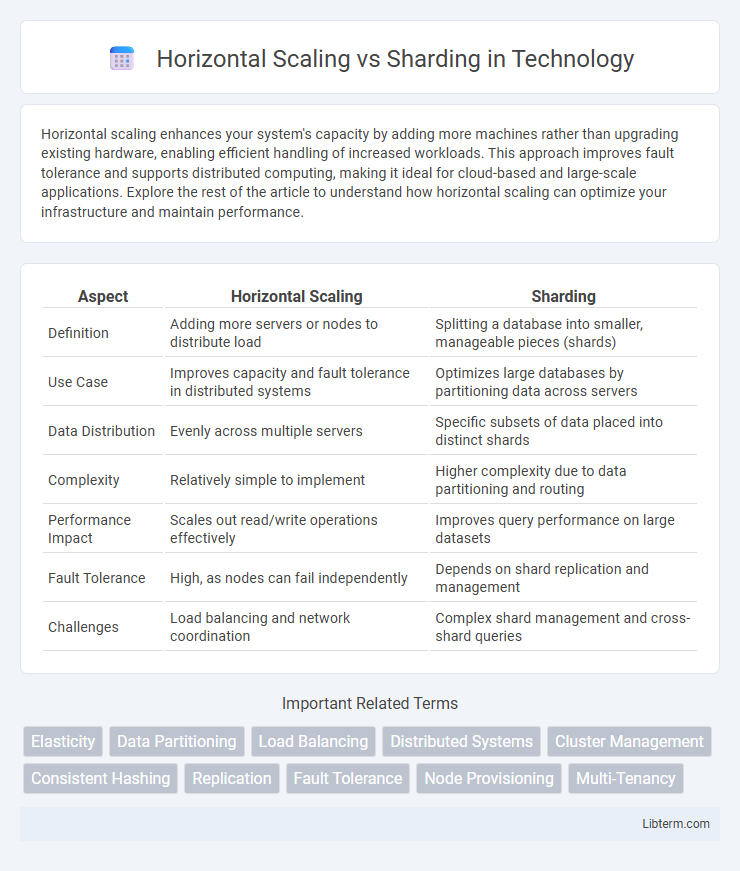Horizontal scaling enhances your system's capacity by adding more machines rather than upgrading existing hardware, enabling efficient handling of increased workloads. This approach improves fault tolerance and supports distributed computing, making it ideal for cloud-based and large-scale applications. Explore the rest of the article to understand how horizontal scaling can optimize your infrastructure and maintain performance.
Table of Comparison
| Aspect | Horizontal Scaling | Sharding |
|---|---|---|
| Definition | Adding more servers or nodes to distribute load | Splitting a database into smaller, manageable pieces (shards) |
| Use Case | Improves capacity and fault tolerance in distributed systems | Optimizes large databases by partitioning data across servers |
| Data Distribution | Evenly across multiple servers | Specific subsets of data placed into distinct shards |
| Complexity | Relatively simple to implement | Higher complexity due to data partitioning and routing |
| Performance Impact | Scales out read/write operations effectively | Improves query performance on large datasets |
| Fault Tolerance | High, as nodes can fail independently | Depends on shard replication and management |
| Challenges | Load balancing and network coordination | Complex shard management and cross-shard queries |
Introduction to Horizontal Scaling and Sharding
Horizontal scaling improves system capacity by adding more servers or nodes to distribute workload, enhancing performance and fault tolerance. Sharding divides a database into smaller, independent pieces called shards, each hosted on different servers to facilitate efficient data management and query processing. Both techniques handle increasing data loads but apply different architectural strategies to optimize scalability and responsiveness.
Defining Horizontal Scaling
Horizontal scaling, also known as scaling out, involves adding more servers or nodes to distribute the workload and increase capacity. This approach improves performance and fault tolerance by spreading data or requests across multiple systems. Unlike sharding, which partitions a database into smaller, independent pieces, horizontal scaling typically duplicates the entire dataset across all nodes to balance traffic efficiently.
Understanding Sharding
Sharding is a database partitioning technique that distributes data across multiple machines or nodes, improving performance and scalability by parallelizing query processing and storage. Unlike horizontal scaling, which simply adds more replicas or servers to handle load, sharding divides the dataset into smaller, more manageable pieces called shards, each responsible for a subset of data. Effective sharding requires careful design of shard keys and mechanisms to ensure data consistency, fault tolerance, and minimal cross-shard communication.
Key Differences between Horizontal Scaling and Sharding
Horizontal scaling involves adding more servers to distribute workload evenly across a system, enhancing performance and capacity without altering the database schema. Sharding, a specific form of horizontal scaling, partitions the database into smaller, manageable pieces called shards, each hosting a subset of the data to improve query efficiency and reduce latency. The key difference lies in horizontal scaling expanding resources at the server level, while sharding splits the data itself across multiple databases or servers for optimized access and storage.
Use Cases for Horizontal Scaling
Horizontal scaling is ideal for applications requiring seamless handling of growing user traffic or data volume by adding more servers or nodes, enhancing performance and availability. It suits web services, e-commerce platforms, and cloud-based applications where load distribution and fault tolerance are critical. Horizontal scaling enables real-time data processing and supports microservices architectures, making it the preferred choice for scalable, high-traffic environments over sharding.
Use Cases for Sharding
Sharding is ideal for large-scale databases handling massive amounts of data and high transaction volumes, such as social media platforms, e-commerce sites, and IoT applications where distributing data across multiple servers reduces latency and improves performance. It allows horizontal partitioning by key ranges or hash functions, enabling efficient parallel queries and write operations while maintaining data accessibility. Use cases benefiting from sharding include real-time analytics, multi-tenant SaaS applications, and financial systems requiring scalability and fault tolerance.
Benefits of Horizontal Scaling
Horizontal scaling enhances system performance by distributing workloads across multiple servers, ensuring higher availability and fault tolerance. It enables seamless resource expansion without downtime, accommodating growing user demands and data volume efficiently. This approach reduces bottlenecks and improves response times, making it ideal for scalable and resilient architectures.
Advantages of Sharding
Sharding enhances database performance by distributing data across multiple servers, enabling faster query response times and improved load balancing. It offers superior scalability by allowing independent growth of individual shards, reducing the risks of bottlenecks common in horizontal scaling. Moreover, sharding provides increased fault tolerance, as failures in one shard do not impact the availability or performance of others.
Challenges and Drawbacks of Each Approach
Horizontal scaling faces challenges such as increased complexity in load balancing and data synchronization across multiple servers, potentially leading to latency issues and inconsistent data states. Sharding introduces difficulties in maintaining data integrity and executing cross-shard transactions, which can complicate query processing and require complex routing logic. Both approaches demand significant infrastructure management and can increase operational costs due to the need for advanced monitoring and failover mechanisms.
Choosing the Right Solution for Your Architecture
Horizontal scaling increases capacity by adding more servers to distribute workload, ideal for applications requiring flexible resource allocation and fault tolerance. Sharding partitions data across multiple databases based on a sharding key, optimizing query performance for large datasets with distinct segments. Choosing between horizontal scaling and sharding depends on your architecture's need for data consistency, complexity of queries, and growth patterns, with sharding suited for massive data distribution and horizontal scaling better for load balancing stateless services.
Horizontal Scaling Infographic

 libterm.com
libterm.com